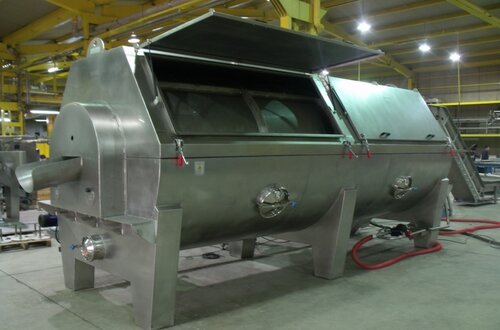Frozen Peas Processing Plant
The Frozen Peas Processing Plant produces frozen peas using a complete set of frozen peas-making machines. Peas, also known as garden peas, are widely used in many cuisines as nutritious vegetables. Peas are typically frozen to enjoy at their peak. Peas are the most popular frozen vegetable. Peas are a delicious and nutrient-dense food that should be consumed by practically everyone. Protein, vitamins, minerals, and soluble fibre are all found in abundance in them.
They may also be used in several other ways. Peas may be cooked and prepared in a variety of ways, and they can enhance the flavour and appeal of a variety of foods. Peas have the added benefit of being quite inexpensive to purchase. Peas may be used to produce soups, puddings, and porridges in addition to being a component of a meal. Salads, stews, pies, spaghetti, and omelettes are just a few of the dishes where they shine.
Peas are cryogenically frozen at a frozen peas processing plant. By travelling through a tunnel cooled by liquid nitrogen to as low as -80- -120° F, the Peas' outer layers are quickly cooled to -80- -120° F. As the meal exits the cryogenic tube, heat from the food's core seeps out, resulting in a stable frozen state. Immersion is also employed in several products. After being immersed in an ultra-cooled liquid for a few seconds, foods with a thick sauce or sticky surface can be frozen by air-blasting.
The temperature of the frozen peas processing plants has been reduced and kept below the freezing point for storage and transit until they are ready to eat. They can Frozen peas are occasionally used with other dishes like pasta or cheese. Frozen fruits are made using a similar approach. Frozen peas processing plants offer various benefits over fresh peas, including availability when fresh counterparts are out of season, a long shelf life when frozen and having been processed one step closer to consumption (Usually washed and cut, sometimes also seasoned). They are sometimes less expensive to purchase than their fresh counterparts or packaged while still ripe.
Frozen peas are harvested, rinsed, blanched, and sliced before being frozen and packed at low temperatures in a frozen peas processing plant. The freezing method used in the Frozen peas processing plant assists in the long-term preservation of fresh foods while keeping their flavour, colour, texture, and nutritional value. Frozen fruits and vegetables are available in sliced, raw, pureed, and cubed forms. These foods offer various advantages over their fresh counterparts, including quicker preparation time, reduced cost, and year-round availability.
Furthermore, rising consumer health awareness and comprehension of the nutritional value of frozen fruits and vegetables are moving the market ahead. Frozen peas are being fueled by the world's rapidly expanding cold storage networks, which are leading to a regular and reliable supply of frozen fruits and vegetables. Frozen peas are readily accessible in supermarkets and are rapidly growing in importance in the global food industry. Fruits and vegetables are often frozen within hours of harvesting, and when thawed, they have a flavour and feel extremely similar to fresh food.
Frozen dinners are becoming increasingly popular among time-pressed homes. If the dinner can be made in the microwave, the period from the freezer to the table can be as little as five minutes. Because most pathogens are inactivated at low temperatures, freezing is a safe method of preservation that also delivers a fresh flavour and convenience. Depending on the food product, the optimum freezing methods for frozen peas processing plants vary a lot.
It's also worth noting that not all foods freeze well. Certain varieties of peas and strawberries, for example, have been demonstrated to freeze well. This may be owing to their firm texture or the high sugar content. As a consequence, farmers will grow these special varieties for a frozen food company.
The frozen food business may be traced back to the early twentieth century when some foods were preserved using the "cold-pack" method. Fruits and vegetables would be washed and sorted before being loaded into massive containers that could hold up to 400 pounds. The large containers were held in a cold storage chamber for many days until the material was thoroughly frozen.
frozen peas processing plant Process
The peas are initially seeded during the winter season in the frozen peas processing plant. The seed is sown at a spacing of 10 cm between the rows, depending on the variety and period. Because of the low germination rate, the largest seed amount is utilized when it is sown early. Peas thrive in warm areas with enough humidity, provided that enough moisture is available throughout flowering and maturity.
Humus-rich and well-draining soils are preferred. Because pea crops do not require regular watering and cannot withstand standing water, drainage systems are required for pea production. Rhizobium bacteria, which live in symbiosis in the root nodules, allow the plant to absorb nitrogen from the air.
Because peas are only harvested in India from November to February, it is in the interest of the frozen peas processing plant to spread the pea supply as widely as possible during this time. To achieve this coverage, sowing is carried out according to a timetable known as a seed scheme. Furthermore, early and late varieties of peas can be benefited.
Sugar is converted into starch during ripening, causing the peas to become harder. Furthermore, the grain skin hardens. A tender meter can thus be used to determine the best time to harvest. The round peas are light green when harvested. Wrinkled peas are available in both light and dark green varieties. When the tender meter value is excessively high.
The percentage of unwanted parts is calculated to determine the deterrent effect of the washer. This percentage is also included in the raw material price. Dirt is frequently removed from frozen peas processing plants using shake and drum sieves as well as a blower. A flotation washer is used because peas are extremely vulnerable. A funnel is used to feed the peas into the machine. The remaining coarse and heavy dirt particles are removed in the first section of the flotation washer. The stream that forms at the washer's bottom is so powerful that only the heavier parts sink. Because bark, leaves, and pea peels are lighter than soaked peas, they are sorted in the second section of the washer.
The peas are transported to the sorting machine in a frozen peas processing plant using a conveyor belt or water. The peas are sorted here. Sorting is important because the size of a pea determines its subsequent processing, as well as the difference in filling weight, starch content, and price. The peas sorter is made up of three to five rotating clover leaf-shaped, perforated drums with a diameter of about two meters that are placed on top of each other.
Water is used to transport the peas to the upper drum, which has 8 mm perforations. The sieved peas are collected in a gutter and transported with water to a 7-mm perforated drum. After sorting, the peas are blanched in a frozen peas processing plant. The peas are cooked at 75 to 80°C for 2 to 4 minutes, depending on their sorting classification. Following that, the peas are rinsed with cold water to inhibit the formation of thermophilic microbes.
Furthermore, this procedure eliminates any starch from the peas, ensuring that there will be no muddy water. Blanching destroys any cell moisture from gently crushed peas, which might create taste discrepancies when exposed to air. After processing, the most crucial activity is packing, which is easy to handle and sell. The peas can be packed in a variety of packing materials and a variety of sizes and shapes.
Our principal
Kiron Food Processing Technologies in association with Bigtem offers a complete Frozen peas processing plant solution for your business. Bigtem is a world leader in this industry, producing processing lines for more than half of the frozen vegetables produced worldwide.








